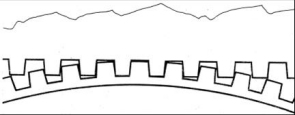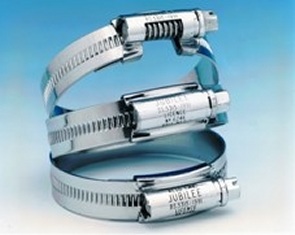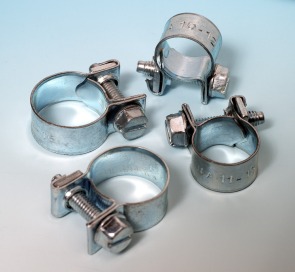432
Using Jubilee clips
correctly and choosing the correct size
Ian Jennings, who runs
L. Robinson & Co (Gillingham) Limited in Kent (the manufacturer of Jubilee®
Clips), provides a useful guide to using their clips and choosing the correct
size for an auto application. (Aug 11)

Anyone who has worked on a car or engine will undoubtedly have seen a number of
different methods for securing the range of hoses that can be found under a bonnet.
Most will have a preference for particular fastening methods as a result of their
experiences. A good example of this is spring clips, often favoured by manufacturers
as they are easy to fit for robots with their penchant for linear movements. They
can, however, be something of a nemesis to the mechanic who has to remove them,
often at the expense of a small quantity of his own blood. Typically they would
be replaced by something adjusted with a conventional tool such as a spanner,
a socket, or a screwdriver. There are two main types of fastener that fall into
this category, nut and bolt clips and worm drive hose clips. Although they perform
ostensibly the same task (that of securing a hose onto a fitting) they are quite
different.
Worm drive clip
A well made worm drive clip, the
best known of which is the UK manufactured Jubilee® Clip, should provide a
vastly superior clamping force as well as a better seal under pressure and a higher
tightening torque than a nut and bolt clip. However there are issues with using
a worm drive clip on a smaller bore hose. Considering how the two products work
the reason is clear. With a worm drive clip the screw is at a tangent to the threaded
band. If the radius of the clip is too tight then it cannot engage properly and
will not work. The number of teeth that can be engaged increases with clip diameter.
Although there will never be more than one tooth fully engaged there can be several
partially engaged teeth either side of the fully engaged one on the largest sizes
of clip.
These problems are minimised with Jubilee® Clips in two
main ways:
Firstly, the teeth are finer than typically seen on other
clips (14.1 teeth per inch compared to typically 12tpi), which gives more partially
engaged teeth on all clips and specifically on the smaller clips.

The other factor is that the housings of Jubilee® Clips are pressed into
the correct radius for that size of clip. Fourteen different radii of housing
are used across the Jubilee® range which ensures a proper seal, so long as
the correct size of clip is used. Even though a clip can be tightened beyond the
correct minimum (and this can be useful to get out of a tight spot) the seal achieved
will likely perform poorly under pressure if too large a clip is used. So, a good
quality worm drive hose clip such as a Jubilee® Clip offers an excellent solution
down to 9.5mm diameter, but not below that. |

Jubilee®
Clip, the best known worm drive clip.
Nut and bolt clip
This is where the nut and bolt type clip comes in.
The nut is fully engaged around the circumference of the bolt regardless of the
size of the clip. It is still important to choose the correct size of clip because
the range of adjustment is limited by the length of the bolt; there is also a
torque induced across the bolt as it is pulled around to fit the radius it is
being secured around, which it will naturally resist. The torque that can be achieved
with a nut and bolt clip is restricted to the force required to bend the two steel
forms that hold the nut and the bolt in place, once this has been exceeded the
fastening becomes no tighter and the clip will simply deform.

Jubilee Junior, a nut and bolt clip.
A Jubilee Junior (nut and bolt clip)
has a recommended tightening torque of 1.5Nm compared to a recommended tightening
torque of 3.4Nm for the smallest (000) Jubilee® standard range worm drive
clip of 9.5-12mm. With a nut and bolt clip the recommended torque is the same
for all sizes, because it is the same nut, the same bolt and the same steel that
will deform. With a worm drive clip, where it should be the engaged teeth of the
screw and band that fail, the recommended tightening torques increase with the
number of teeth engaged, or to put it another way, with the size of the clip.
With the Jubilee® range of products there is a slight overlap in the
size ranges because, with soft hoses or plastic spigots, it may be that a nut
and bolt style clip, such as a Jubilee Junior, would offer a better seal. This
is due to the thinner band material which is less rigid and will take the shape
of the fitting at a lower torque than a worm drive clip with a thicker band would.
Usually this is the preference of the mechanic.
The most important thing
then is to select the correct size of clip. All Jubilee® standard clips and
Jubilee Juniors have the recommended adjustment range stamped on the band to make
size selection easier. With the right size of a good quality hose clip in place
the mechanic can be happy that all of his good repair work is up to the highest
standard and be satisfied in another job well done. You can see the Jubilee website
at: www.jubileeclips.co.uk/
Back
to homepage |



